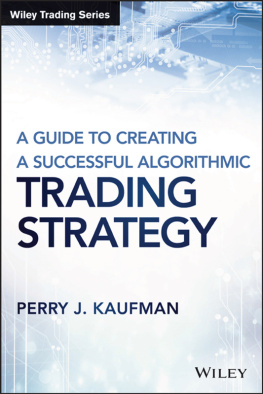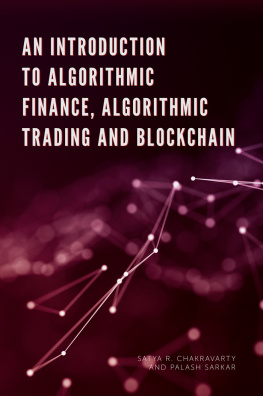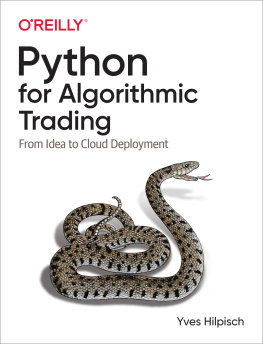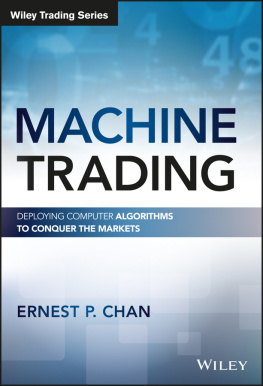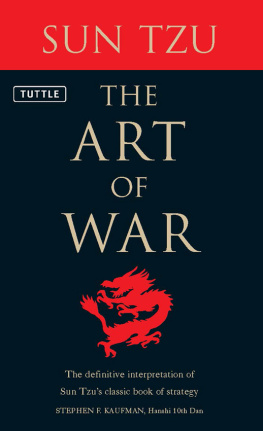Perry J. Kaufman - A Guide to Creating a Successful Algorithmic Trading Strategy
Here you can read online Perry J. Kaufman - A Guide to Creating a Successful Algorithmic Trading Strategy full text of the book (entire story) in english for free. Download pdf and epub, get meaning, cover and reviews about this ebook. year: 2015, publisher: Wiley, genre: Business. Description of the work, (preface) as well as reviews are available. Best literature library LitArk.com created for fans of good reading and offers a wide selection of genres:
Romance novel
Science fiction
Adventure
Detective
Science
History
Home and family
Prose
Art
Politics
Computer
Non-fiction
Religion
Business
Children
Humor
Choose a favorite category and find really read worthwhile books. Enjoy immersion in the world of imagination, feel the emotions of the characters or learn something new for yourself, make an fascinating discovery.
- Book:A Guide to Creating a Successful Algorithmic Trading Strategy
- Author:
- Publisher:Wiley
- Genre:
- Year:2015
- Rating:5 / 5
- Favourites:Add to favourites
- Your mark:
- 100
- 1
- 2
- 3
- 4
- 5
A Guide to Creating a Successful Algorithmic Trading Strategy: summary, description and annotation
We offer to read an annotation, description, summary or preface (depends on what the author of the book "A Guide to Creating a Successful Algorithmic Trading Strategy" wrote himself). If you haven't found the necessary information about the book — write in the comments, we will try to find it.
A Guide to Creating a Successful Algorithmic Trading Strategy — read online for free the complete book (whole text) full work
Below is the text of the book, divided by pages. System saving the place of the last page read, allows you to conveniently read the book "A Guide to Creating a Successful Algorithmic Trading Strategy" online for free, without having to search again every time where you left off. Put a bookmark, and you can go to the page where you finished reading at any time.
Font size:
Interval:
Bookmark:

The Wiley Trading series features books by traders who have survived the market's ever changing temperament and have prosperedsome by reinventing systems, others by getting back to basics. Whether a novice trader, professional or somewhere in-between, these books will provide the advice and strategies needed to prosper today and well into the future. For more on this series, visit our website at www.WileyTrading.com.
Founded in 1807, John Wiley & Sons is the oldest independent publishing company in the United States. With offices in North America, Europe, Australia and Asia, Wiley is globally committed to developing and marketing print and electronic products and services for our customers' professional and personal knowledge and understanding.
Cover image: Top: Raimundas/Shutterstock; Bottom: argus /Shutterstock
Cover design: Wiley
Copyright 2016 by Perry J Kaufman. All rights reserved.
Published by John Wiley & Sons, Inc., Hoboken, New Jersey.
Published simultaneously in Canada.
No part of this publication may be reproduced, stored in a retrieval system, or transmitted in any form or by any means, electronic, mechanical, photocopying, recording, scanning, or otherwise, except as permitted under Section 107 or 108 of the 1976 United States Copyright Act, without either the prior written permission of the Publisher, or authorization through payment of the appropriate per-copy fee to the Copyright Clearance Center, Inc., 222 Rosewood Drive, Danvers, MA 01923, (978) 750-8400, fax (978) 646-8600, or on the Web at www.copyright.com. Requests to the Publisher for permission should be addressed to the Permissions Department, John Wiley & Sons, Inc., 111 River Street, Hoboken, NJ 07030, (201) 748-6011, fax (201) 748-6008, or online at www.wiley.com/go/permissions.
Limit of Liability/Disclaimer of Warranty: While the publisher and author have used their best efforts in preparing this book, they make no representations or warranties with respect to the accuracy or completeness of the contents of this book and specifically disclaim any implied warranties of merchantability or fitness for a particular purpose. No warranty may be created or extended by sales representatives or written sales materials. The advice and strategies contained herein may not be suitable for your situation. You should consult with a professional where appropriate. Neither the publisher nor author shall be liable for any loss of profit or any other commercial damages, including but not limited to special, incidental, consequential, or other damages.
For general information on our other products and services or for technical support, please contact our Customer Care Department within the United States at (800)
762-2974, outside the United States at (317) 572-3993, or fax (317) 572-4002.
Wiley publishes in a variety of print and electronic formats and by print-on-demand. Some material included with standard print versions of this book may not be included in e-books or in print-on-demand. If this book refers to media such as a CD or DVD that is not included in the version you purchased, you may download this material at http://booksupport.wiley.com. For more information about Wiley products, visit www.wiley.com.
ISBN 978-1-119-22474-7 (Hardcover)
ISBN 978-1-119-22476-1 (ePDF)
ISBN 978-1-11-9-22475-4 (ePub)
My special thanks to three people with incredible knowledge in this area, and who could have easily written this themselves, John Kowalik, John Ehlers, and Linda Raschke. They generously provided very extensive and insightful comments that resulted in numerous changes and hopefully, considerably more clarity. My appreciation also goes to Mark Rzepczynski, who tenaciously questioned some of my conclusions and to Ernie Varitimos and Murray Ruggiero for their insight.
To my mother, Helen, who has proofread every book that Ive written. If you find any errors, please direct your comments to her.
Thank you all.
PJK
* * *
A reminder from Barbara Rockefellers Morning Forex Briefing:
The researches of many commentators have already thrown much darkness on this subject, and it is probable that if they continue we shall soon know nothing at all.
Mark Twain
A Brief Introduction: The Ground Rules
Everything should be made as simple as possible, but not simpler.
Albert Einstein
If you havent heard it, a classic example of trading experience is the difference between a statistician and a trader. You flip a coin 99 times and it comes up heads each time. You ask the statistician, What are the odds that it will come up heads next time? The statistician answers, 50:50. You ask the trader the same question and he answers, 100 percent. Surprised, you ask the trader, Why? He responds, Because it couldnt possibly be a fair coin. The odds of getting 99 heads in a row are too high to have happened by chance. Experience transforms theory into reality.
When I first started trading using automated systems in the early 1970s, the very idea was demeaned by professional traders as ridiculous, the market just doesnt work that way, you cant make money if you dont know the value of the stock. Now that opinion seems to have been turned upside down. High frequency trading, the algorithmic trading system on steroids, has an unfair advantage, its stealing money from the ordinary investor. Times have changed, but attitudes have not.
This is a no-frills book. Its short because it just deals with the most important issues of developing a successful trading system and because youre more likely to read it all. It is intended to be a painless lesson in reality, those critical steps that you learn over time, often by doing them wrong. For some, it will be a confirmation that youre getting it right, and for others it may be an Aha! moment. It would be more responsible, and more scientific, to verify each of my conclusions yourself. But, if youre like me, you readily accept ideas that are reasonable and seem right, and you choose to believe them. Ive been uncertain at times, but I rarely regret a decision that comes from common sense.
Each chapter contains, in my opinion, the best way to deal with the various aspects of creating a trading system. All of the steps are important, and doing them incorrectly will show up later in your trading account, perhaps too late. Its better to spend a little extra time up front to increase your chances of success later on.
Before we get immersed in the details, there are some important items to define and disclose.
First, we all have biases. They are often found in what we dont say rather than what we actually state. I see that when I watch the political commentary on television and also in the evening news. Everyone seems to have an agenda.
My own biases are toward fully automatic trading, which include all the good and bad of it. I also like macrotrend systems, stock and various other arbitrage, and some pattern recognition, among other methods that I cant remember right now. I dont like systems with a lot of rules and Im suspicious of systems that work on only one market. Im going to try to balance my examples to show short-term and long-term systems, but the reality is that there will probably be more about long-term trend following, which I believe is used by more traders, especially at the early stages when they are dangling their collective toes in the water.
The process of developing a trading strategy involves eight well-defined steps, shown in . These should be clear, except for the marks on the left that show Change rules and Failed. From the top down, the trading idea comes first, then you need to get all the data that will be used to validate your strategy. You must have a trading platform to test your idea, which could be as simple as Excel, or as sophisticated as TradeStation. You enter your rules using that platform.
Next pageFont size:
Interval:
Bookmark:
Similar books «A Guide to Creating a Successful Algorithmic Trading Strategy»
Look at similar books to A Guide to Creating a Successful Algorithmic Trading Strategy. We have selected literature similar in name and meaning in the hope of providing readers with more options to find new, interesting, not yet read works.
Discussion, reviews of the book A Guide to Creating a Successful Algorithmic Trading Strategy and just readers' own opinions. Leave your comments, write what you think about the work, its meaning or the main characters. Specify what exactly you liked and what you didn't like, and why you think so.

